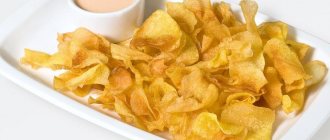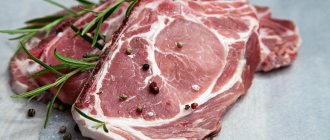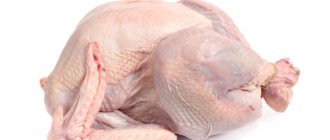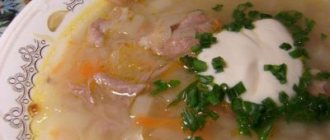Sauerkraut is a delicious, sour product loved by many. But not everyone knows about its beneficial and medicinal properties. The product normalizes intestinal function and improves digestion, promotes weight loss and strengthens the immune system thanks to the vitamins and minerals it contains. Cabbage is good for athletes to eat - it reduces pain in the joints and muscles that regularly appear after physical training. Cabbage juice and brine have healing properties.
BJU, composition and calorie content
The composition of sauerkraut is rich in micro- and macroelements, vitamins, and organic acids, thanks to which the product has a positive effect on human health. The calorie content of cabbage is low and amounts to 27 kcal per 100 g. The ratio of BJU in 100 grams of sauerkraut is 1: 0.3: 3.4, respectively.
The energy value of the product per 100 g varies depending on the method of preparation, namely:
- sauerkraut with butter – 61.2 kcal;
- with carrots – 30.1 kcal;
- stewed – 34.8 kcal;
- boiled – 23.6 kcal;
- Lenten/meat cabbage soup from sauerkraut – 20.1/62.3 kcal;
- dumplings with sauerkraut – 35.6 kcal.
Nutritional value of the product per 100 g:
- carbohydrates – 5.3 g;
- proteins – 1.6 g;
- fats – 0.1 g;
- water – 888.1 g;
- dietary fiber – 4.1 g;
- organic acids – 79.2 g;
- ash – 0.7 g.
Due to its low fat content, sauerkraut can be eaten while on a diet or used as an aid to weight loss.
The chemical composition of the product per 100 g is presented in the form of a table:
| Component name | Quantity in the product |
| Manganese, mg | 0,16 |
| Aluminum, mg | 0,49 |
| Iron, mg | 0,8 |
| Zinc, mg | 0,38 |
| Iodine, mg | 0,029 |
| Calcium, mg | 284,1 |
| Sodium, mg | 21,7 |
| Phosphorus, mg | 29,7 |
| Calcium, mg | 50 |
| Sulfur, mg | 34,5 |
| Magnesium, mg | 16,4 |
| Chlorine, mg | 1249,1 |
| Vitamin A, mg | 0,6 |
| Vitamin PP, mg | 0,97 |
| Thiamine, mg | 0,03 |
| Vitamin B6, mg | 0,1 |
| Vitamin E, mg | 0,2 |
| Ascorbic acid, mg | 38,1 |
| Folates, mcg | 8,9 |
| Vitamin B2, mg | 0,04 |
In addition, the product contains starch in the amount of 0.2 g and monosaccharides - 5 g per 100 g, as well as probiotics (beneficial bacteria) and antioxidants.
Sauerkraut juice, like brine, contains a similar set of useful and nutritious elements.
Juice is the liquid obtained by squeezing sauerkraut in a juicer. Brine is a fermentation product in which cabbage is fermented.
Description of the vegetable
White cabbage can be eaten raw or after heat treatment.
The vegetable itself has a spherical shape, and its edible part is hidden under spreading green leaves, which are not eaten when the head is removed from the garden. Cabbage belongs to the Cruciferous family and is its oldest representative. The BJU ratio of white cabbage today classifies the vegetable as a dietary product. It is included in their diet by everyone who monitors their health and figure.
The chemical composition of the crop largely depends on the characteristics of cultivation, but if all standards are met, it has the average indicators indicated below. Cabbage is grown in temperate climates. Both in private farmsteads and on an industrial scale.
It is no coincidence that many people are interested in such a question as the calorie content of cabbage. Cabbage is considered a light, low-calorie product, which is why it is often included in various diets, in one form or another.
It should be noted that cabbage is one of the main agricultural vegetable crops. It is believed that the birthplace of cabbage is the Mediterranean, where it has been grown since the third millennium BC.
There are many types of cabbage, more than a hundred, but the most common is white cabbage.
Let us immediately note that white cabbage has low calorie content, but this is not all that it is useful for.
White cabbage differs from other vegetables in the presence of vitamin U, which is also known as methylmethionine.
The important properties of vitamin U for us are that it helps treat gastric and duodenal ulcers, gastritis, and ulcerative colitis.
Cabbage is a rich source of vitamin C. Compared to potatoes, cabbage contains 50 times more ascorbic acid, and 10 times more than carrots. In terms of vitamin C content, cabbage surpasses even tangerines and lemons.
True, its early varieties contain only 20 mg%, but the later ones already contain 70 mg%. Moreover, vitamin C is stored in cabbage for a long time, since it exists in it in the most stable form - ascorbigen.
Of course, cabbage also contains a number of other vitamins: B1, B2, PP, vitamin B9, pantothenic acid. It contains compounds of phosphorus, calcium, and potassium. Cabbage can boast of having almost all the vitamins a person needs.
In addition, white cabbage contains minerals and easily soluble sugars, such as sucrose, fructose, glucose. This is especially true for glucose - there is more of it than in apples, oranges, and lemons.
The dietary properties of cabbage are varied. White cabbage enhances metabolic processes, relieves pain and relieves inflammation. It is recommended to eat it for atherosclerosis, for cardiac ischemia, for gout, for heart and kidney diseases, for gastritis with low acidity, for constipation.
Cabbage is contraindicated for enteritis, colitis, diarrhea, myocardial infarction. But if there is no exacerbation, white cabbage can and should be consumed - especially boiled - because, thanks to vitamin U, it protects the intestinal mucosa from the appearance of ulcers.
We invite you to read: Where do Drosophila flies come from in an apartment or house? How to get rid of fruit flies in the apartment, in the kitchen, in flowers: tips. How to make traps for fruit flies with your own hands: instructions
https://youtu.be/-5p3aMSoEsQ
Useful properties of sauerkraut
Sauerkraut is a source of compounds essential for the full functioning of the body.
It has beneficial properties that have a positive effect on health, namely:
- Strengthens the bone skeleton and also stimulates its growth. Reduces pain in joints and muscle tissue, which is important for athletes and people who undergo heavy physical activity.
- Reduces cholesterol and triglyceride levels in the blood, thereby improving the functioning of the cardiovascular system. Systematic consumption of the product normalizes blood pressure and sugar levels (which is especially useful for diabetes), and reduces the risk of heart disease.
- Strengthens the nervous system and improves brain function. It is recommended to include cabbage in the diet of people suffering from diseases such as multiple sclerosis, epilepsy, and autism.
- Improves visual acuity, reduces the risk of cataracts and macular degeneration.
- Strengthens the functioning of the immune system, thanks to which the body copes with viral and colds faster.
- Stimulates the gastrointestinal tract, relieves inflammatory processes. Sauerkraut is recommended for people suffering from irritable bowel syndrome.
- Improves skin condition, reduces the manifestation of skin diseases and eczema.
- Prevents bladder diseases.
The healing effects of sauerkraut
Such a simple product as sauerkraut can have a healing effect on the body. But only if it is a high-quality product prepared according to all the rules.
- Sauerkraut is used as a preventive and therapeutic agent for erectile dysfunction. Systematic use of the product strengthens male sexual power and prevents early impotence.
- When used regularly, the product acts as a preventative against lung, intestinal and breast cancer, and helps fight cancer in the early stages.
- Eating cabbage reduces symptoms of headaches or joint pain.
- The condition of the oral mucosa improves, which accelerates the healing process of small cracks and ulcers, and freshens breath.
Cabbage brine helps treat liver diseases and reduces hangover symptoms. For pregnant women, brine helps fight toxicosis. The juice cleanses the intestines of toxins and poisons and improves digestion.
Sauerkraut contains 4.3 g of carbohydrates per 100 g of product, which is approximately 77% of the total energy from a serving or 17 kcal. Calorie content - 19 kcal. Ingredients of sauerkraut:
fats - 0.14 g, proteins - 0.91 g, carbohydrates - 4.28 g, water - 92.52 g, ash - 2.15 g.
Total sugar content - 1.8 g, fiber - 2.9 g, starch - n/a.
Cholesterol content - 0.0 mg, trans fats - 0.0 g.
Can you add meat to a stew?
The question of the nutritional value of a dish with vegetables has been resolved; there remains one more point that you will probably want to clarify - how many calories will be contained in stewed cabbage if you add a little meat to it.
In fact, the fat content of a meat dish will depend on the proportions and energy value of additional ingredients. Here you should also be guided by the 70/30 principle and give most of the space in the pan to the white cabbage beauty.
The calorie content of a dish with meat in this case will be:
- 102 kcal if you use minced chicken;
- 150-155, if you prepare a stew with white chicken meat;
- 145 kcal - this is what 100 grams of a dish with the addition of pork will contain (without fat);
- You'll get about 160 calories by adding beef.
If you cook vegetables with pork, try to remove as much fat from the pieces as possible. Otherwise, you will not get a dietary, but a very nutritious meal with a calorie content of 180 units. It is best to choose chicken fillet or minced meat - 100 grams of such a stew will not harm your figure, but will allow you to enjoy the taste.
On the dietary side, the stew will be a great way to lose a couple of extra pounds. But remember, if you are on a cabbage diet, it is best to prepare the product by adding vegetables and a little oil. You should also supplement your diet with dairy products - low-fat yogurt and cottage cheese, whole grain cereals (oatmeal is great), honey and white chicken meat.
To support your immune system and provide your body with essential vitamins, use apples, grapefruits, oranges and kiwis as snacks. This way you can support your body and lose excess weight.
≫ More information
Cabbage is one of the most popular vegetables among those who watch their figure and adhere to the basics of a healthy diet. It contains very few calories. For example, the nutritional value of the most popular white cabbage is only 27 calories. It should be borne in mind that during the cooking process the calorie content of a vegetable can increase many times. To ensure that the prepared product has a lower calorie content, meat should not be used. It is better to give preference to vegetables and mushrooms as an additional component.
IT IS IMPORTANT TO KNOW! Fortune teller Baba Nina:
“There will always be plenty of money if you put it under your pillow...” Read more >>
Vitamins
Among the fat-soluble vitamins, sauerkraut contains A, beta-carotene, alpha-carotene, E and K. Among the water-soluble vitamins are vitamins C, B1, B2, B3 (PP), B4, B5, B6 and B9.
>’> >’> >’> >’> >’> >’> >’> >’> >’> >’> >’> >’> >’> >’> >’> >’> >’>
| Vitamins, content | Share of daily value per 100 g | |
| Vitamin A | 1.0 mcg | 0,1% |
| Beta carotene | 8.0 mcg | 0,2% |
| Alpha carotene | 5.0 mcg | 0,1% |
| Vitamin D | 0.0 µg | 0,0% |
| Vitamin D2 | n/a | 0,0% |
| Vitamin D3 | n/a | 0,0% |
| Vitamin E | 0.1 mg | 1,0% |
| Vitamin K | 13.0 mcg | 10,8% |
| Vitamin C | 14.7 mg | 16,3% |
| Vitamin B1 | 0.0 mg | 1,8% |
| Vitamin B2 | 0.0 mg | 1,7% |
| Vitamin B3 | 0.1 mg | 0,9% |
| Vitamin B4 | 10.4 mg | 2,1% |
| Vitamin B5 | 0.1 mg | 1,9% |
| Vitamin B6 | 0.1 mg | 10,0% |
| Vitamin B9 | 24.0 mcg | 6,0% |
| Vitamin B12 | 0.0 µg | 0,0% |
Recipe? Recipe!
Products:
- cabbage:500 grams
- apple: 1 pc.
- celery: 1 stalk
- vinegar: ¼ cup
- sugar: ½ tablespoon
- vegetable oil: 2 tablespoons
- salt
We suggest you read: Slugs on cabbage, fighting them
Pre-peeled white cabbage is finely chopped. Then salt the cabbage and grind until the juice is released and the consistency is soft. The apple is peeled and cut into slices, and the celery is cut into thin strips (4-5 cm long).
Mineral composition
The ratio of mineral substances (macro- and microelements) contained in sauerkraut is presented in the table using diagrams.
>’> >’> >’> >’> >’> >’> >’> >’> >’> >’> >’>
| Minerals, content | Share of daily value per 100 g | |
| Calcium | 30.0 mg | 3,0% |
| Iron | 1.5 mg | 14,7% |
| Magnesium | 13.0 mg | 3,3% |
| Phosphorus | 20.0 mg | 2,9% |
| Potassium | 170.0 mg | 3,6% |
| Sodium | 661.0 mg | 50,8% |
| Zinc | 0.2 mg | 1,7% |
| Copper | 0.1 mg | 10,7% |
| Manganese | 0.2 mg | 6,6% |
| Selenium | 0.6 mcg | 1,1% |
| Fluorine | 7.0 mcg | 0,2% |
Report errors and inaccuracies
- Glasses 0.7 1 glass - how much?
- The calculations use the weight of only the edible part of the product.
Listed below are the nutrient standards that apply to the site.
Nutritional value and chemical composition of “White cabbage, pickled.”
| Nutrient | Quantity | Norm** | % of the norm in 100 g | % of the norm in 100 kcal | 100% normal |
| Calorie content | 23 kcal | 1684 kcal | 1.4% | 6.1% | 7322 g |
| Squirrels | 1.8 g | 76 g | 2.4% | 10.4% | 4222 g |
| Fats | 0.1 g | 56 g | 0.2% | 0.9% | 56000 g |
| Carbohydrates | 3 g | 219 g | 1.4% | 6.1% | 7300 g |
| Organic acids | 1.1 g | ||||
| Alimentary fiber | 2 g | 20 g | 10% | 43.5% | 1000 g |
| Water | 89 g | 2273 g | 3.9% | 17% | 2554 g |
| Ash | 3 g | ||||
| Vitamins | |||||
| Vitamin A, RE | 1 mcg | 900 mcg | 0.1% | 0.4% | 90000 g |
| beta carotene | 0.008 mg | 5 mg | 0.2% | 0.9% | 62500 g |
| Vitamin B1, thiamine | 0.02 mg | 1.5 mg | 1.3% | 5.7% | 7500 g |
| Vitamin B2, riboflavin | 0.02 mg | 1.8 mg | 1.1% | 4.8% | 9000 g |
| Vitamin B4, choline | 10.4 mg | 500 mg | 2.1% | 9.1% | 4808 g |
| Vitamin B5, pantothenic | 0.093 mg | 5 mg | 1.9% | 8.3% | 5376 g |
| Vitamin B6, pyridoxine | 0.13 mg | 2 mg | 6.5% | 28.3% | 1538 g |
| Vitamin B9, folates | 24 mcg | 400 mcg | 6% | 26.1% | 1667 g |
| Vitamin C, ascorbic acid | 30 mg | 90 mg | 33.3% | 144.8% | 300 g |
| Vitamin E, alpha tocopherol, TE | 0.1 mg | 15 mg | 0.7% | 3% | 15000 g |
| Vitamin K, phylloquinone | 13 mcg | 120 mcg | 10.8% | 47% | 923 g |
| Vitamin RR, NE | 0.6 mg | 20 mg | 3% | 13% | 3333 g |
| Niacin | 0.4 mg | ||||
| Macronutrients | |||||
| Potassium, K | 300 mg | 2500 mg | 12% | 52.2% | 833 g |
| Calcium, Ca | 48 mg | 1000 mg | 4.8% | 20.9% | 2083 g |
| Magnesium, Mg | 16 mg | 400 mg | 4% | 17.4% | 2500 g |
| Sodium, Na | 930 mg | 1300 mg | 71.5% | 310.9% | 140 g |
| Sera, S | 9.1 mg | 1000 mg | 0.9% | 3.9% | 10989 g |
| Phosphorus, Ph | 31 mg | 800 mg | 3.9% | 17% | 2581 g |
| Microelements | |||||
| Iron, Fe | 0.6 mg | 18 mg | 3.3% | 14.3% | 3000 g |
| Manganese, Mn | 0.151 mg | 2 mg | 7.6% | 33% | 1325 g |
| Copper, Cu | 96 mcg | 1000 mcg | 9.6% | 41.7% | 1042 g |
| Selenium, Se | 0.6 mcg | 55 mcg | 1.1% | 4.8% | 9167 g |
| Fluorine, F | 7 mcg | 4000 mcg | 0.2% | 0.9% | 57143 g |
| Zinc, Zn | 0.19 mg | 12 mg | 1.6% | 7% | 6316 g |
| Digestible carbohydrates | |||||
| Starch and dextrins | 0.1 g | ||||
| Mono- and disaccharides (sugars) | 2.9 g | max 100 g | |||
| Saturated fatty acids | |||||
| Saturated fatty acids | 0.034 g | max 18.7 g | |||
| Polyunsaturated fatty acids | |||||
| Omega-3 fatty acids | 0.033 g | from 0.9 to 3.7 g | 3.7% | 16.1% | |
| Omega-6 fatty acids | 0.034 g | from 4.7 to 16.8 g | 0.7% | 3% |










